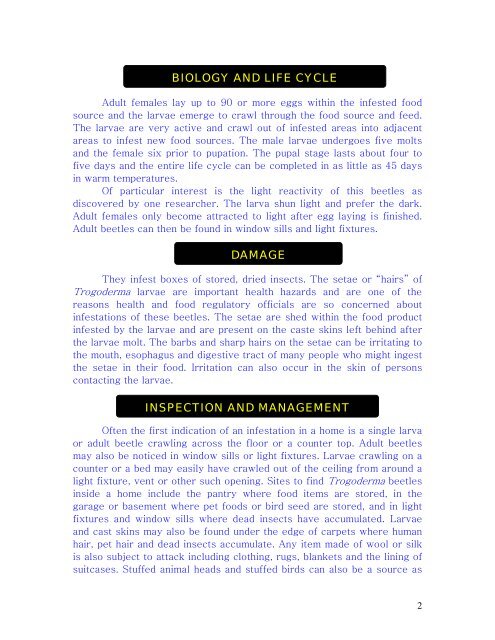warehouse and cabinet beetles
warehouse and cabinet beetles
warehouse and cabinet beetles
Create successful ePaper yourself
Turn your PDF publications into a flip-book with our unique Google optimized e-Paper software.
BIOLOGY AND LIFE CYCLE<br />
Adult females lay up to 90 or more eggs within the infested food<br />
source <strong>and</strong> the larvae emerge to crawl through the food source <strong>and</strong> feed.<br />
The larvae are very active <strong>and</strong> crawl out of infested areas into adjacent<br />
areas to infest new food sources. The male larvae undergoes five molts<br />
<strong>and</strong> the female six prior to pupation. The pupal stage lasts about four to<br />
five days <strong>and</strong> the entire life cycle can be completed in as little as 45 days<br />
in warm temperatures.<br />
Of particular interest is the light reactivity of this <strong>beetles</strong> as<br />
discovered by one researcher. The larva shun light <strong>and</strong> prefer the dark.<br />
Adult females only become attracted to light after egg laying is finished.<br />
Adult <strong>beetles</strong> can then be found in window sills <strong>and</strong> light fixtures.<br />
DAMAGE<br />
They infest boxes of stored, dried insects. The setae or “hairs” of<br />
Trogoderma larvae are important health hazards <strong>and</strong> are one of the<br />
reasons health <strong>and</strong> food regulatory officials are so concerned about<br />
infestations of these <strong>beetles</strong>. The setae are shed within the food product<br />
infested by the larvae <strong>and</strong> are present on the caste skins left behind after<br />
the larvae molt. The barbs <strong>and</strong> sharp hairs on the setae can be irritating to<br />
the mouth, esophagus <strong>and</strong> digestive tract of many people who might ingest<br />
the setae in their food. Irritation can also occur in the skin of persons<br />
contacting the larvae.<br />
INSPECTION AND MANAGEMENT<br />
Often the first indication of an infestation in a home is a single larva<br />
or adult beetle crawling across the floor or a counter top. Adult <strong>beetles</strong><br />
may also be noticed in window sills or light fixtures. Larvae crawling on a<br />
counter or a bed may easily have crawled out of the ceiling from around a<br />
light fixture, vent or other such opening. Sites to find Trogoderma <strong>beetles</strong><br />
inside a home include the pantry where food items are stored, in the<br />
garage or basement where pet foods or bird seed are stored, <strong>and</strong> in light<br />
fixtures <strong>and</strong> window sills where dead insects have accumulated. Larvae<br />
<strong>and</strong> cast skins may also be found under the edge of carpets where human<br />
hair, pet hair <strong>and</strong> dead insects accumulate. Any item made of wool or silk<br />
is also subject to attack including clothing, rugs, blankets <strong>and</strong> the lining of<br />
suitcases. Stuffed animal heads <strong>and</strong> stuffed birds can also be a source as<br />
2



